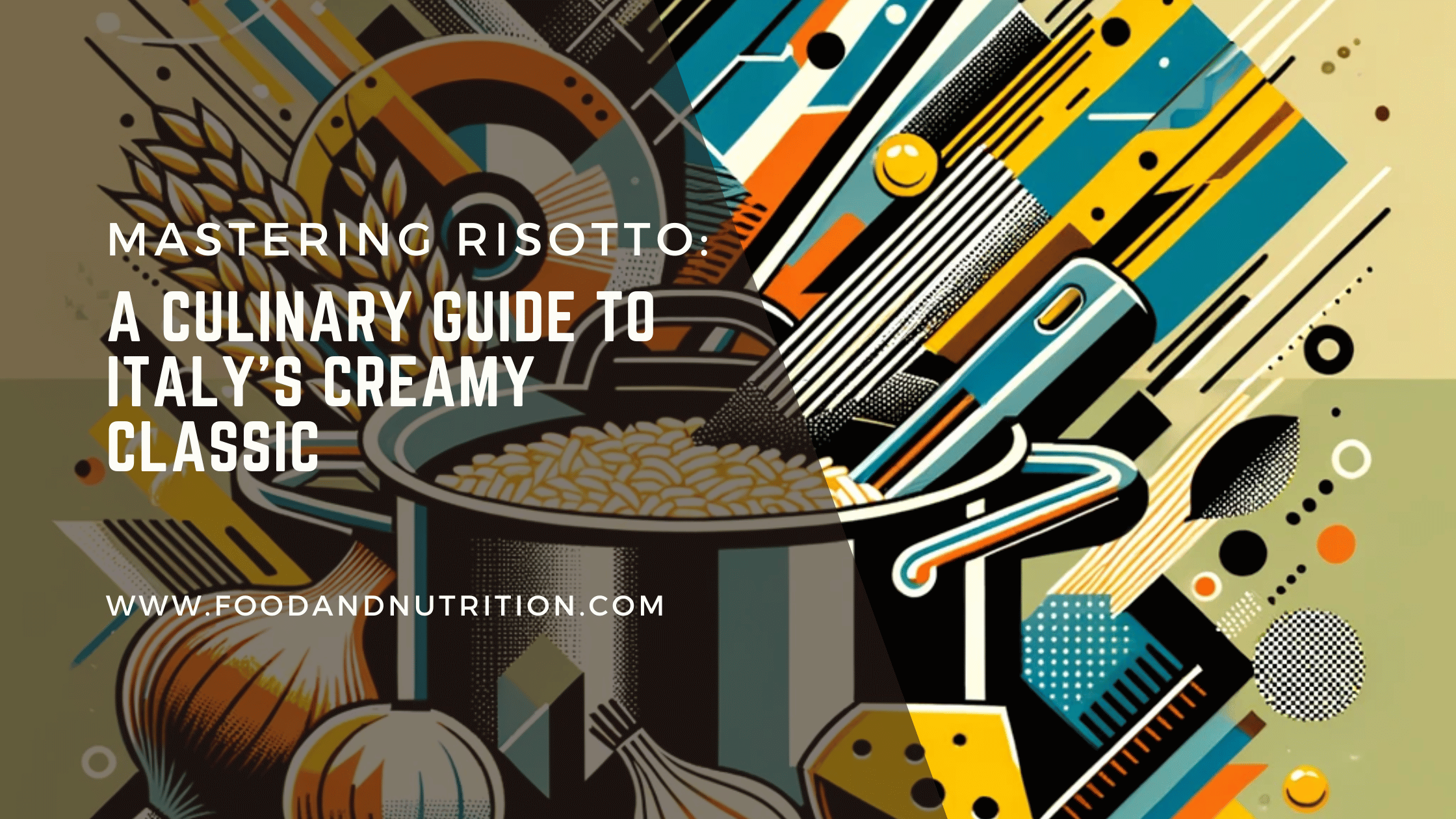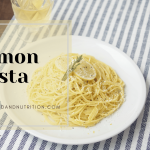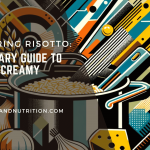Mastering Risotto: A Culinary Guide to Italy’s Creamy Classic

Welcome to a culinary exploration where tradition meets innovation, and where each spoonful tells a story of flavor, health, and science. Today, we delve into the world of risotto, a dish that has captivated food enthusiasts and home cooks alike with its creamy texture and rich tapestry of tastes. But risotto is more than just a staple of Italian cuisine; it’s a fascinating blend of culinary art, nutritional balance, and food science.
As a registered dietitian, my goal is to guide you through the nuances of this beloved dish, from its humble origins in Northern Italy to the science behind its signature creamy texture. We’ll uncover the secrets of choosing the right rice, mastering the perfect cooking technique, and understanding the nutritional profile of this comforting classic. Whether you’re a seasoned risotto aficionado or a curious beginner eager to try your hand at this dish, our journey through the art and science of risotto promises to enrich your appreciation and inspire your culinary adventures.
Join us as we answer some of the most common questions about risotto, offering both professional insights and practical tips. We’ll explore how risotto turns rice into a creamy sauce, why specific rice types are preferred, and how risotto can fit into various dietary preferences without losing its essence. So, grab your apron and a wooden spoon; we’re about to stir our way into the heart of Italian culinary tradition, one deliciously creamy bite at a time.
Risotto in the Culinary World
The Heritage of Risotto
Risotto, more than just a dish, is a reflection of Italian culinary heritage. Originating from Northern Italy, particularly the regions of Lombardy and Piedmont, risotto has been a staple of Italian cuisine since the Middle Ages. It symbolizes the marriage of local ingredients and regional cooking traditions. The dish’s evolution over centuries mirrors Italy’s culinary history, characterized by a deep appreciation for local produce and meticulous cooking methods.
Risotto’s simplicity belies its rich cultural backdrop. Traditionally, it was a way for Italian families to celebrate the flavors of their local ingredients, particularly rice, which thrives in the Po Valley. Each region in Italy offers its own variation of risotto, from Risotto alla Milanese with its luxurious saffron hues in Milan to the seafood-infused Risotto al Nero di Seppia in Venice.
Classic Risotto Ingredients
The beauty of risotto lies in its simplicity and the quality of its ingredients. At its core, risotto features the following key components:
- Rice: The star of the dish, traditional risotto rice like Arborio, Carnaroli, and Vialone Nano, is prized for its high starch content and ability to absorb flavors while maintaining a firm texture.
- Broth: Whether it’s vegetable, chicken, beef, or seafood, the broth infuses the rice with depth and warmth. The gradual addition of warm broth is crucial for the creamy consistency.
- Onion and Garlic: These aromatics lay the flavor foundation. Sautéed gently, they add a subtle yet essential base note to the dish.
- White Wine: A splash of white wine adds acidity and complexity, balancing the richness of the risotto.
- Butter and Parmesan Cheese: Added towards the end, they bring a velvety texture and a hint of richness to the risotto.
In the next section, we will explore the science behind these ingredients and how they harmonize to create risotto’s signature creamy texture.
The Science of Risotto Rice
Choosing the Right Rice
In the world of risotto, not all rice is created equal. The secret to its creamy texture lies in using the right type of rice. Varieties such as Arborio, Carnaroli, and Vialone Nano are preferred for their high starch content, particularly a type of starch called amylopectin. This starch is key to risotto’s creamy consistency, as it breaks down and releases into the cooking liquid during the slow cooking process.
- Arborio: The most commonly used risotto rice, Arborio is known for its large, plump grains and excellent ability to absorb flavors.
- Carnaroli: Often hailed as the ‘king of risotto rice’, Carnaroli offers a slightly firmer texture and is more forgiving to cook, making it a favorite among chefs.
- Vialone Nano: Preferred in the Veneto region, this variety is smaller in grain size but exceptional in absorbing liquids and flavors, ideal for creamier risottos.
Each of these varieties contributes to the dish’s overall texture and mouthfeel, making the choice of rice a crucial first step in risotto preparation.
Starch Dynamics in Cooking
Understanding the science of starch in risotto is essential. The process of cooking risotto involves a method known as starch gelatinization. As the rice cooks and absorbs the hot broth, its starch granules swell and soften. This gradual absorption and constant stirring cause the outer layer of the rice grains to release starch into the broth, thickening it and creating the dish’s signature creamy texture.
This creamy texture is not just about mouthfeel; it’s also a marker of perfectly cooked risotto. The goal is to achieve a balance where the rice grains are ‘al dente’ – tender yet with a slight bite – surrounded by a velvety, starchy sauce. This delicate equilibrium is the hallmark of a well-executed risotto, showcasing the harmony between culinary technique and food science.
In our next section, we’ll delve into the culinary techniques that transform these scientific principles into a delicious reality, exploring the art of mastering risotto preparation.
Mastering Risotto Technique
Culinary Techniques for Perfect Risotto
The art of making risotto is as much about technique as it is about ingredients. Achieving the perfect risotto is a dance of precision and patience. Here’s how you can master this culinary art:
- Sauté Aromatics: Start by gently sautéing onions (and sometimes garlic) in butter until they are translucent. This step lays a flavorful foundation.
- Toast the Rice: Add the rice, stirring it into the aromatics to coat each grain with butter. This toasting phase, known as ‘tostatura’, is crucial for flavor development and helps the grains absorb liquid without becoming mushy.
- Deglaze with Wine: A splash of white wine adds complexity and depth. The alcohol cooks off, leaving behind a subtle acidity that balances the richness.
- Add Broth Gradually: This is where patience plays a key role. Add warm broth one ladle at a time, allowing the rice to absorb the liquid gradually. This slow absorption is key to releasing the starches that give risotto its creamy texture.
- Stir Constantly: Continuous stirring prevents the rice from sticking to the bottom of the pot and ensures even cooking. It also aids in the even release of starch.
- Finish with Fats: Once the rice is al dente, finish the dish with a knob of butter and grated Parmesan cheese. These fats emulsify with the starchy broth, creating a rich, velvety finish.

Food Science Behind Cooking Risotto
The magic of risotto lies in its transformation at the molecular level. The constant stirring and gradual addition of broth facilitate the release of amylopectin, the starch responsible for the creaminess. As the rice cooks, the gentle heat causes these starch molecules to swell and burst, thickening the surrounding liquid into a rich sauce.
Moreover, the final addition of butter and cheese isn’t just for flavor. The fats in these ingredients emulsify with the starchy broth, enhancing the creamy texture. This emulsification is a crucial step in achieving the luxurious mouthfeel that is synonymous with a well-made risotto.
In the next section, we’ll explore the nutritional aspects of risotto, offering insights into how this delectable dish fits into a balanced diet.
Nutritional Profile of Risotto
Risotto’s Nutritional Breakdown
While risotto is often celebrated for its rich flavor and creamy texture, it’s also worth examining its nutritional profile. A traditional risotto, with its combination of rice, broth, butter, and cheese, can offer a range of nutrients:
- Carbohydrates: As a rice-based dish, risotto is primarily a source of carbohydrates, providing energy. The type of rice used also impacts the nutritional value; whole grain varieties, for instance, offer more fiber.
- Fats: The addition of butter and cheese contributes fats, some of which are saturated. Using olive oil as a substitute for butter can introduce heart-healthy monounsaturated fats.
- Protein: While risotto is not high in protein, the cheese does contribute a small amount. Including a protein-rich side dish or adding protein-rich ingredients like chicken or seafood can balance this.
- Vitamins and Minerals: Depending on the ingredients used (such as vegetables or seafood), risotto can be a source of various vitamins and minerals.
Risotto can fit into a balanced diet when consumed in moderation and paired with nutrient-rich foods.
Healthier Risotto Variations
Risotto’s versatility allows for numerous healthier adaptations without compromising on flavor:
- Whole Grain Rice: Using whole grain rice like brown Arborio or farro can increase the fiber content and add nutritional complexity.
- Low-Sodium Broth: Opting for a low-sodium broth reduces the overall salt content, making it a heart-friendly option.
- Vegetable-Forward: Incorporating a variety of vegetables increases the dish’s vitamin, mineral, and fiber content.
- Lean Proteins: Adding lean proteins such as chicken, turkey, or fish can make the dish more filling and nutritionally balanced.
In the next section, we will share some delightful risotto recipes that not only tantalize your taste buds but also contribute positively to your dietary goals.
Traditional Mushroom Risotto
Ingredients
- 1 cup Arborio rice
- 2 tablespoons olive oil substitute for butter for a healthier option
- 1 small onion finely chopped
- 2 cloves garlic minced
- ½ cup white wine optional
- 4 cups low-sodium vegetable broth kept warm
- 1 cup mushrooms sliced
- ½ cup grated Parmesan cheese use a reduced-fat version if preferred
- Salt and pepper to taste
- Fresh parsley chopped, for garnish
Instructions
- In a pan, heat olive oil over medium heat. Sauté onion and garlic until translucent.
- Add Arborio rice, stirring to coat with oil. Cook until the edges become slightly translucent.
- Pour in wine (if using), stirring until absorbed.
- Gradually add warm broth one ladle at a time, stirring constantly until each addition is absorbed before adding more.
- Halfway through, add mushrooms.
- Once rice is creamy and al dente, remove from heat. Stir in Parmesan cheese. Season with salt and pepper.
- Garnish with parsley and serve.
Notes
Risotto for Every Diet
Adapting Risotto to Dietary Needs
Risotto’s flexibility makes it a welcoming dish for various dietary preferences and restrictions. Here’s how you can tailor risotto recipes to meet different dietary needs:
- Gluten-Free Risotto: Traditionally, risotto is gluten-free, as it’s made with rice. However, ensure that all broth and added ingredients are certified gluten-free.
- Dairy-Free and Vegan Risotto: Substitute butter with olive oil and Parmesan cheese with nutritional yeast or a vegan cheese alternative. Use vegetable broth for a completely plant-based version.
- Low-Carb Risotto: For a lower carbohydrate option, consider using cauliflower rice. This alternative offers a similar texture with significantly fewer carbs and higher vitamin C content.
Low-Calorie and Low-Carb Alternatives
- Cauliflower Risotto:
- Replace rice with finely chopped cauliflower for a low-carb, high-fiber alternative. Add your choice of vegetables and spices for flavor.
- Broccoli and Cheese Risotto:
- Utilize broccoli rice as a base, combined with low-fat cheese, for a nutritious and satisfying low-calorie meal.
- Mushroom and Spinach Quinoa Risotto:
- Quinoa, a protein-rich seed, can be a fantastic risotto base, especially when combined with nutrient-dense vegetables like mushrooms and spinach.
Each of these alternatives offers a way to enjoy the essence of risotto while aligning with specific health goals and dietary preferences.
Conclusion
Risotto is a testament to the harmony of flavor, nutrition, and culinary science. From its humble beginnings in Northern Italy to its evolution into a global culinary icon, risotto remains a dish that invites creativity and experimentation. Whether you’re adhering to a specific diet or simply looking for a comforting, nutritious meal, risotto offers endless possibilities. We hope this journey through the art and science of risotto inspires you to explore this classic dish in your own kitchen, discovering new flavors and nutritional benefits along the way.
Call to Action
We’d love to hear from you! Share your risotto creations, experiences, or any innovative twists you’ve tried. Join our community of food enthusiasts and health-conscious cooks as we continue to explore the delightful world of culinary arts and nutrition. Happy cooking!

